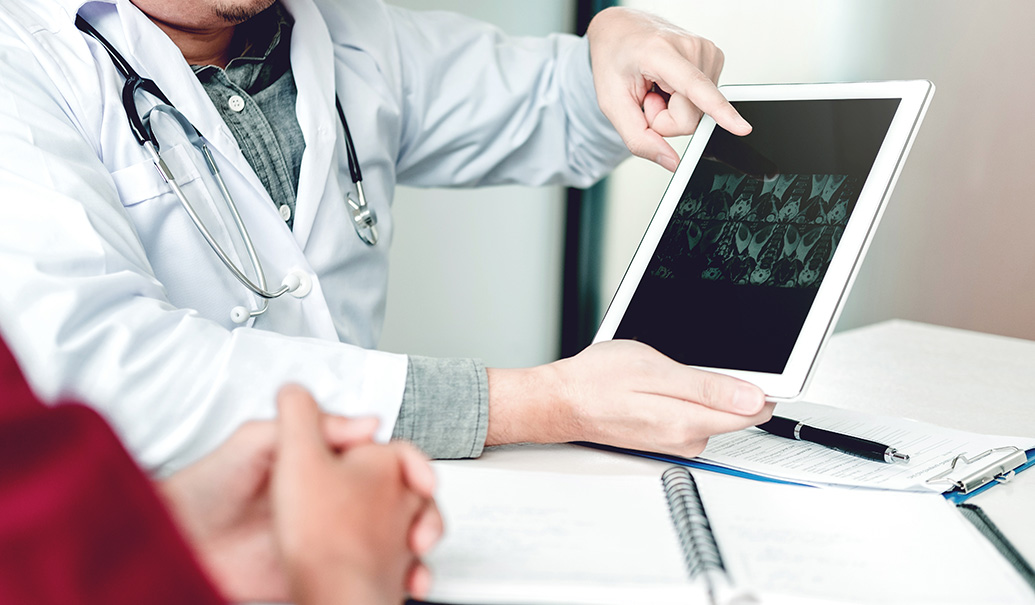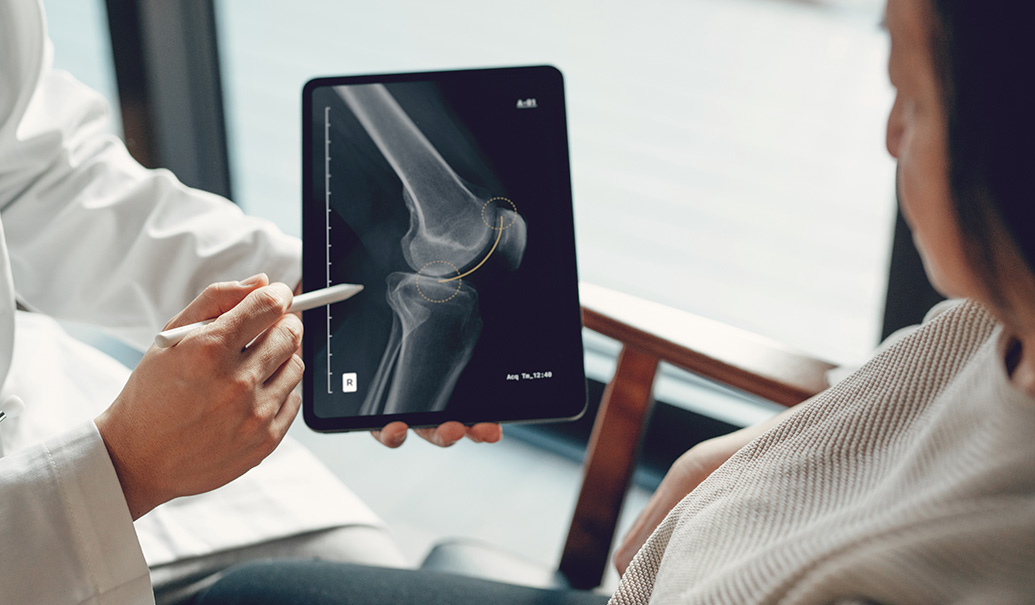Tech innovation and data have become day-to-day features in the lives of consumers worldwide, with products that now inform household and business behaviors. This data-driven reality has also expanded to healthcare by giving doctors and patients more opportunity than ever to engage with analytics related to treatment. As a result, medtech companies have started exploring ways to partner with other tech companies to meet this growing demand.
In 2018, orthopedics-focused medical device manufacturer Zimmer Biomet took the forward-thinking step of pursuing a partnership with Apple. The resulting mymobility® app, which recently announced new remote care management features and metrics, leverages the functionality of the iPhone and Apple Watch to give knee and hip joint replacement patients a closer, personalized look at their care before and after their procedures. ZS principal Brian Chapman sat down with Yvonne Bokelman, Zimmer Biomet’s president and general manager of strategic and value-based solutions, for a conversation on what both companies have gained from the collaboration and how these insights are being used to deliver better service to their customer base.
Brian Chapman: How do companies partner with a tech company, especially one such as Apple? What is it that they're looking for? How do you make that successful?
Yvonne Bokelman: Partnerships are going to be the wave of the future. Everyone has a little bit of the pie in terms of data, expertise, clinical evidence, etc. Our partnership with Apple was years in the making. Lots of initial conversations happened with [our] leadership talking to Apple leadership about what a relationship could look like, what we each brought to the table, how we could continue to expand on it and if we shared the same goals in musculoskeletal health. We had both specialized and complementary skill sets that could help change the standard of care using data and technology. That initial groundwork is what we needed to develop goals.
BC: We talk a lot about how data has value in this new economy, especially in healthcare. Do you have any thoughts on how we should be thinking about data ownership as a medtech community?
YB: We had a number of internal discussions about that and how it would work in the [Apple] relationship. The collection of data, who maintains the data, who owns the data, data privacy—all of those were key issues that had to be discussed and contracted through and it could be different for each device company that’s thinking about a partnership. We have an appropriate data-sharing agreement that allows both companies to meet their goals. [But] who really owns the data? It's the patient's information, so managing and appropriately safeguarding it, using what you can and knowing what has to be aggregated or de-identified… all those play into this.
BC: You took an important step to conduct a randomized controlled trial (RCT) for some aspects of mymobility. Can you talk about how that's structured, and the decision process for why you went with such a rigorous, traditional method versus emerging, maybe unproven methods of using real-world evidence to support outcomes?
YB: We approached our mymobility study in three different phases. The first phase we called our early learning cohort, which enrolled a few hundred patients. The intent was to see if this could be successfully incorporated into the healthcare delivery process. Can you use this technology? Can you use this application easily in a busy practice? Does it work in an academic medical center or an ambulatory surgery center? You want to be confident you could say, "Doctor, you and your patient will easily be able to do this. It doesn't add time to your practice,” so the acceptance would be there. That proved out as we thought it would. Then we began our RCT. We are about a year in and just finished enrollment in February. I think RCTs are the gold standard, and we know that payers and other stakeholders typically prefer to see an RCT in terms of how they look at data. There will ultimately be messaging that resonates with these stakeholders as we look at further expansion. The RCT will enroll a thousand patients to prove the platform is able to look at total joint replacement outcomes, patient experience and the economic story. If things end as we think they will, we'll have a strong story for mymobility plus Apple Watch as a cost-saving, clinically appropriate platform to manage total joint cases. That's step two, and we're about there. While we run the RCT we’re also doing what we call a correlative study in which we continue to collect data via mymobility and the health kit biometrics and look at PROMS [patient-reported outcome measures] and post-surgery outcomes. We targeted that study for up to 10,000 patients. We may find we don't have to go that high to get the kind of data we need but we’re certainly set up to do that. We'll continue that beyond the RCT.
BC: One of the things with medical devices that I know surgeons struggle with is that they don't often receive feedback on their procedures to understand what's working and what isn't, and they aren't often in touch with their patients in the medium to long term. Is this a mechanism that could address that? Or are your aspirations for mymobility more specific to payers and generally advancing the therapy?
YB: It's definitely advantageous to the provider. The care team—the physician and whoever else they’ve designated in their practice—is getting a constantly updated dashboard. Mymobility is customized for every entity we provide it to. A physician's pre-op and post-op care protocol is all built in there. They get very specific real-time dashboards back about how the patient's doing, if they’re complying with activities, and if the appropriate reminders are being adhered to, so there's a two-way communication that’s happening. If someone in the office sees something, they can immediately be in contact with the patient or alert the physician to be in contact with the patient. Patients could take pictures if indicated, and upload them to get feedback, as well as a dashboard of [patient] activity to assure compliance with physical therapy. The studies are ongoing but anecdotally we hear positive feedback from both patients and providers about having this information, and the time savings in the office setting by being able to handle things over messaging or by phone, versus needing an appointment to answer simple questions or offer the patient reassurance.
BC: What you're describing—the challenges of creating two-way communication—is not unique to orthopedics. One challenge we often see is that opening dialogue takes time from the care team, and one of the barriers to digital health solutions is how that time is not recognized or paid for within a DRG [diagnosis-related group] system. Are you seeing positive signs or concerns in how this is evolving, especially if such a solution becomes more ubiquitous across the industry?
YB: That's a great point. The technology is ahead of coding and reimbursement systems, but [the systems] are catching up and starting to think in the right way. There has been an influx of codes in the last couple of years, some of which are designed to provide some level of reimbursement to physicians for setting up technology or reviewing care in a remote monitoring environment. There is a code that would allow physicians to seek reimbursement once every 30 days for assessing and appropriately documenting patient information. What is occurring in this particular space is that when you're paid for the surgery as a provider, there aren't typically other payments made in a 90-day period. We would advocate that it should still be a separate payment because there is work being done, and there is value and cost savings to the system. We are also interested in determining if there is a need beyond the 90 days to continue to monitor certain health parameters. What are the benefits to care in doing that? Technology has changed the way we deliver care and what that post-acute period looks like, so coding and reimbursement needs to adapt from the old system of paying for a surgery that only covers a [limited] time period.
BC: Seeing how care coordination can extend beyond a short period of time and outside of orthopedics is very exciting. Is there an opportunity for Zimmer Biomet to expand beyond what you have today, or do you feel like you would be perfectly happy to stay within orthopedics and improve the quality of care there?
YB: We're obviously very happy to be in orthopedics and improve the quality of life for our patients. There's an opportunity while we're doing this study and having mymobility commercially available for practices and hospitals to utilize. Some see it as a draw to their practice to show how they've enhanced communications and level of care. As you look at the growth of data acquisition and evidence, there will be chances to monetize in the future. What that looks like is something every device company is likely talking about and trying to determine if there's something that works and provides value.
BC: The shift from being a device manufacturer to playing a much broader role within the healthcare continuum is fascinating to think about. You've described a lot of amazing functionality that you've developed. Could you give us a glimpse into the potential for a digital health solution like mymobility?
YB: It’s different in a device company to have this conglomeration of professionals doing software development and creation and constantly iterating. Mymobility has had multiple versions since we've launched it. Like any app, there are constant updates that make interfaces more friendly or add information. We continue to push for expansion of mymobility [beyond] the total joint, hip and knee spaces. We've advanced into sports. We want to be a solution for the rest of the Zimmer Biomet portfolio. [Additionally], how do you use this as a platform to integrate with other data sources? The major orthopedic and spine companies are rolling out robotics, as are general surgery companies, etc. We're certainly evaluating that.
BC: There’s so much potential in connecting what happens before and during the intervention with eventual outcomes. Think about the ability within orthopedics to have clear imaging before you start and a well-quantified understanding of what you did, and then being able to rapidly advance the surgeon’s technique. Do you think we could get there? What barriers do we need to get through?
YB: It's very realistic. If you're a surgeon and you can see that a particular angle or cut works in a patient who has certain demographics, history or indications, then as you look at that you begin to match and see where you're successful. It's one thing to be able to do a dump of broad data, but it's going to be much more effective when we can provide analytics that allow the physician to see the data in a different way and make better decisions. The data in healthcare has been coming fast and furious, and making those connections to process it in a meaningful way will be key to its value.
BC: What's keeping us from getting there now?
YB: For a traditional device company, it's a change in how you look at things. Companies need to reflect on whether they have the data sources and infrastructure or whether they have to partner to get some of it. What data do you have as a company that would be even more valuable if it had input from other areas? How do you create the environment to do that?
BC: How can companies handle all of this data and develop apps in an area that is not historically data-driven or savvy in these types of technical and creative pursuits?
YB: We had a great team and visionary leadership before me who knew we needed to get beyond the implant. We acquired a company a few years back that had both the post-acute expertise and a gaming platform, so we were experimenting in that setting and thinking about what we could do. We started building out this broader group within our organization called Connected Health. We brought in talent—from software developers to data scientists to implementation teams—and then built out a creative workforce and leadership that thinks in a different way while banking on our traditional core expertise of musculoskeletal health. Connected Health has offices in multiple locations. You go to visit our software development team and it's very different from visiting our manufacturing plant. Having acceptance and support to move in that direction at Zimmer Biomet is very important for us in looking at how we offer solutions across the continuum of care. It's a big commitment.
“The data in healthcare has been coming fast and furious, and making those connections to process it in a meaningful way will be key to its value.”
YVONNE BOKELMAN
BC: Since the payoff is going to be long-term, how do you get that commitment from what's often a relatively conservative industry?
YB: It's been evolutionary for us. We have hit our stride in terms of leadership that really believes in it. We are a leader in the hip and knee implant space, but there are lots of companies that provide implants. So how do you morph yourself into something that is evolving with the healthcare system and the way delivery is changing while providing value? It's been rewarding and humbling to move in that direction and lead other companies in that direction. The Apple relationship has been an advantage; they’re an iconic company with a lot going on in the healthcare space. Being their musculoskeletal partner is a huge deal for us.
BC: We're all familiar with how some everyday consumer apps will update every week or two. That's very different from how frequently you might update, say, blood glucose management software, which is heavily regulated. How is the FDA dealing with what needs to be a very agile space, but one that can't go fast and break things the way Silicon Valley might?
YB: I can’t speak for the inner workings of the FDA, but I know that they have been trying to be flexible and open, and have their eye focused on the digital area. Even AdvaMed, the industry work group, has several digital groups now that are comprised of members of traditional and not-so-traditional device companies, and we’re trying to frame what we would need for reimbursement, overall guidance and how we pursue expansion in this area. Even though mymobility didn't fall into a place that needed to be regulated by the FDA, we took the advance opportunity to talk to them about what we were doing and the way we wanted to study it to keep them in the loop and get their support.
BC: As we start to see care moving further into the digital space and being more reliant on machine learning and data for guidance, what does oversight look like? How do you see the regulatory environment in this new world that you're helping to usher in?
YB: It's hard to say exactly what that's going to look like and how much will be regulated. Some of that may get determined by the final decisions about clinical care. It is doubtful to me that Zimmer Biomet would be directing patient care. That's not what we do. We want to provide information and analytics that would allow [physicians] to do that. If that decision is still happening there, I don't know that there's as much regulatory impact. A lot of companies play in this space and a lot of data is being accumulated. It’s a little bit of wait-and-see about how that's going to roll out and what framework might happen around it. I would challenge companies to keep pushing the envelope like Apple is pushing us and we’re pushing others. It's going to be good for healthcare and for the healthcare delivery. We're all striving to monitor outcomes and making the requisite improvements from what we learn. We want to improve or build upon the standard of care in a positive way. That’s what drives us.














